- DISCLAIMER
- LIST OF TABLES
- LIST OF FIGURES
- LIST OF APPENDICES
- EXECUTIVE SUMMARY
- INTRODUCTION
- METHODS
- RESULTS
- SUBSTANCES
- VICTIMS
- EVACUATIONS
- CONTINGENCY PLANS
- WORLD TRADE CENTER
- USES OF HSEES DATA
- SUMMARY OF RESULTS, 1993-2001
- REFERENCE
- APPENDICES
- Table 1 – Number of events meeting the surveillance definition, by state and type of event, Hazardous Substances Emergency Events Surveillance, 2001
- Table 2 – Distribution of the number of substances released, by type of event, Hazardous Substances Emergency Events Surveillance, 2001
- Table 3 – Distribution of the number of substances released, by substance category and type of event, Hazardous Substances Emergency Events Surveillance, 2001
- Table 4 – Distribution of the number of victims, by type of event, Hazardous Substances Emergency Events Surveillance, 2001
- Table 5 – Number of substances released in all events and events with victims, by substance category, Hazardous Substances Emergency Events Surveillance, 2001
- Table 6 – Distribution of type of injury, by type of event, Hazardous Substances Emergency Events Surveillance, 2001
- Table 7 – Profiles of events with ≥ 50 victims, Hazardous Substances Emergency Events Surveillance, 2001
- Table 8 – Cumulative data for all states, Hazardous Substances Emergency Events Surveillance, 2001
- Figure 1 – Areas of fixed facilities involved in events, Hazardous Substances Emergency Events Surveillance, 2001
- Figure 2 – Distribution of transportation-related events, by type of transport, Hazardous Substances Emergency Events Surveillance, 2001
- Figure 3 – Factors reported as contributing to the occurrence of fixed-facility events, Hazardous Substances Emergency Events Surveillance, 2001
- Figure 4 – Distribution of victims, by population group and type of event, Hazardous Substances Emergency Events Surveillance, 2001
- Figure 5a – Distribution of responder victims for fixed-facility events, by population group, Hazardous Substances Emergency Events Surveillance, 2001
- Figure 5b – Distribution of responder victims for transportation-related events, by population group, Hazardous Substances Emergency Events Surveillance, 2001
- Figure 6 – Distribution of type of injury for all events, Hazardous Substances Emergency Events Surveillance, 2001
- Figure 7 – Injury outcome, Hazardous Substances Emergency Events Surveillance, 2001
- Figure 8 – Distribution of victims, Hazardous Substances Emergency Events Surveillance, 2001
- Figure 9 – Cumulative data for all participating states, Hazardous Substances Emergency Events Surveillance, 2001
- Appendix A – The 100 Most Frequently Released Substances, Hazardous Substances Emergency Events Surveillance, 2001
- Appendix B – Profiles of events with fatalities in fixed facilities, Hazardous Substances Emergency Events Surveillance, 2001
- Appendix C – Profiles of events with fatalities in transportation events, Hazardous Substances Emergency Events Surveillance, 2001
- Appendix D – Hazardous Substances Emergency Events Surveillance-Related Publications
- To describe the distribution and characteristics of hazardous substances emergencies.
- To describe the morbidity and mortality experienced by employees, responders, and the general public as a result of hazardous substances releases.
- To identify risk factors associated with the morbidity and mortality.
- To identify strategies that might reduce future morbidity and mortality resulting from the release of hazardous substances.
- This annual report summarizes the characteristics of hazardous substances releases and the associated public health consequences of events reported to the surveillance system during 2001.
Download Adobe Acrobat (PDF) version - 848KB
Historical Document
This document is provided by the Agency for Toxic Substances and Disease Registry (ATSDR) ONLY as an historical reference for the public health community. It is no longer being maintained and the data it contains may no longer be current and/or accurate.
*In the 2001 Annual Report, errors occurred on Figures 4 and 5b and the following sections: Victims, Evacuations, and Contingency Plans. Corrections have been made to the online reports however, if you have a hardcopy report you will need to reprint page numbers 14-17, 21, and 23. We regret any confusion these errors may have caused.
In 1980, Congress created the Agency for Toxic Substances and Disease Registry (ATSDR) to implement health-related sections of laws that protect the public from hazardous wastes and environmental spills of hazardous substances. The Comprehensive Environmental Response, Compensation, and Liability Act of 1980 (CERCLA), commonly known as the "Superfund" Act, designated ATSDR as the lead agency within the Public Health Service to help prevent or reduce further exposure to hazardous substances and the adverse health effects that result from such exposures, and also to expand the knowledge base about such effects.
This publication reports the results and findings of a health study, registry, or other health-related activity supported by ATSDR in accordance with its legislative mandate described above.
Comments regarding this report are welcome. Please send your comments to the following address:
Agency for Toxic Substances and Disease Registry
Attn: Director, Division of Health Studies (E-31)
1600 Clifton Road, NE
Atlanta, Georgia 30333
Agency for Toxic Substances and Disease Registry
Julie L. Gerberding, MD, MPH, Administrator
Henry Falk, MD, MPH, Assistant Administrator
Robert F. Spengler, ScD, Associate Administrator for Science
Division of Health Studies
G. David Williamson, PhD, Director
Sharon Campolucci, MSN, Deputy Director
Tom Wilson, Editor
Epidemiology and Surveillance Branch
Hazardous Substances Emergency Events Surveillance Staff
Wendy E. Kaye, PhD, Chief
Zahava Berkowitz, MSc
Maureen Orr, MS
Casetta R. Simmons
Perri Zeitz Ruckart, MPH
Kevin Horton, MSPH
Wendy Wattigney, MStat
Use of trade names and commercial sources is for identification only and does not imply endorsement by the Agency for Toxic Substances and Disease Registry or the U.S. Department of Health and Human Services.
CONTENTS
LIST OF TABLES
LIST OF FIGURES
LIST OF APPENDICES
EXECUTIVE SUMMARY
The Hazardous Substances Emergency Events Surveillance (HSEES) system, maintained by the Agency for Toxic Substances and Disease Registry (ATSDR), actively collects information to describe the public health consequences associated with the release of hazardous substances. This report summarizes the characteristics of events reported to the 16 state health departments participating in 2001. Information on acute hazardous substances emergency events was collected, including the substance(s) released, number of victims, number and types of injuries, and number of evacuations. The data obtained were computerized using an ATSDR-provided Web-based data entry system.
A total of 8,978 events was reported. In 8,138 (90.6%) of the events, only a single substance was released. The most commonly reported categories of substances were inorganic substances (excluding acids, bases, ammonia, and chlorine); volatile organic compounds (VOCs); mixtures involving more than one category; and acids. During this reporting period, 710 events (7.9% of all reported events) resulted in a total of 2,168 victims. The most frequently reported injuries sustained by victims were respiratory irritation, headache, dizziness or other central nervous system (CNS) symptoms, and eye irritation. A total of 22 persons died as a result of all events, and 655 (7.3%) events required evacuations.
The findings regarding the distribution of the numbers of events with victims and evacuations, and the numbers and types of injuries reported have, overall, been consistent since HSEES inception.
Since 1990, the Agency for Toxic Substances and Disease Registry (ATSDR) has maintained an active, state-based Hazardous Substances Emergency Events Surveillance (HSEES) system to describe the public health consequences associated with the release of hazardous substances. The decision to initiate a surveillance system of this type was made on the basis of a study published in 1989 on the reporting of hazardous substances releases to three national databases: the National Response Center Database, the Hazardous Materials Information System (HMIS), and the Acute Hazardous Events Database (1). A review of these databases indicated limitations. Many events were missed because of incomplete reporting (for example, the HMIS did not record events involving intrastate carriers or fixed-facility events). Other important information was not recorded, such as the demographic characteristics of victims, the types of injuries sustained, and the number of persons evacuated. As a result of this review, ATSDR implemented the HSEES system to more fully describe the public health consequences associated with the release of hazardous substances. The surveillance system has four goals:
In 2001, 16 state health departments (Alabama, Colorado, Iowa, Louisiana, Minnesota, Mississippi, Missouri, New York, New Jersey, North Carolina, Oregon, Rhode Island, Texas, Utah, Washington, and Wisconsin) collected data for HSEES. For each event, information was collected about the event, substance(s) released, victims, injuries, and evacuations.
Various data sources were used to obtain information about these events. These sources included, but were not limited to, records and oral reports of state environmental protection agencies, police and fire departments, the US Department of Transportation, the National Response Center, and hospitals. Census data were used to estimate the number of residents living in the vicinity of the events. All data were computerized using a Web-based data entry system provided by ATSDR.
Hazardous substances emergency events are defined by HSEES as uncontrolled or illegal releases or threatened releases of hazardous substances. Events involving petroleum and no other hazardous substances are not included. Events are included if (1) the amount of substance that was released (or that might have been released) needed (or would have needed) to be removed, cleaned up, or neutralized according to federal, state, or local law; or (2) there was only a threatened release of a substance, but the threat led to an action (for example, evacuation) that could have affected the health of employees, emergency responders, or the general public. Victims are defined as persons who suffered at least one adverse health effect or died as a consequence of the event. Victims who receive more than one type of injury are counted once in each applicable injury type. Events are defined as transportation-related if they occurred during surface, air, pipeline, or water transport of hazardous substances. All other events are considered fixed-facility events.
For the data analyses in this report, the substances released were categorized into 11 groups. The category "mixtures" consists of mixtures of substances from different categories, and the category "other inorganic substances" comprises all inorganic substances, except for acids, bases, ammonia, and chlorine. "Other" refers to substances that could not be categorized.
A total of 8,978 hazardous substances emergency events was reported for 2001 to the HSEES system; 184 (2.0%) of these events were threatened releases. In 2001, 6,736 (75.0%) of the events occurred at fixed facilities (Table 1).
For each fixed-facility event, one or two choices can be selected for type of area. Of all 7,488 fixed-facility area choices, 1,984 (26.5%) were classified as ancillary processing equipment, 1,029 (13.7%) as a process vessel (a reaction chamber in which chemicals are processed), 869 (11.6%) as piping, and 788 (10.5%) as storage areas above and below ground (Figure 1). Of the 2,242 transportation-related events, 5 involved multiple modes of transportation (3 ground and rail combined and 2 water and pipeline combined). Most events 1,920 (85.4%) occurred during ground transport (for example, truck, van, or tractor), and 210 (9.5%) involved transport by rail (Figure 2). Fewer events involved water, air, pipeline, or unknown transportation modes.
The primary factors contributing to the events were also reported (Figure 3). Equipment failure was the primary contributing factor in 3,395 (37.8%) events, followed by 2,662 events involving operator error (29.67%). More than half, 1,209 (54.0%) of transportation events and 1,453 (21.6%) of fixed-facility events involved human error as the primary factor and 614 (27.4%) of transportation and 2,781 (41.3%) of fixed-facility events involved equipment failure as the primary factor.
Ninety-one percent of all events involved the release of only one substance. Two substances were released in approximately 4% of the events, and 5% involved the release of more than two substances (Table 2).
There were 11,764 substances either released or threatened to be released during the 8,978 events. Two types of releases could be reported for each chemical (e.g., spill and air). Air releases were involved in 5,115 (41.5%) releases, followed by 4,918 (39.9%) spill releases, 496 (4.0%) fires, 575 (4.7%) threatened releases, 99 (0.8%) explosions, and 1,106 (9.0%) unknown or other.
HSEES events were more likely when there was more industrial, commercial, or agricultural activity, e.g., in the 6 hours before noon (36.6%) and the 6 hours after and including noon (31.1%), compared with the 6 hours before midnight (17.5%) and the 6 hours after and including midnight (14.8%) (1,244 records did not have a time specified). Additionally, 15%-17% of events occurred on each weekday as compared with 7%-9% on a weekend day. April through September, the peak agricultural season, had 56% of the events, and the other 6 months of the year had 44%.
There were 11,764 substances released and some events released more than one substance. The substances most frequently released were ammonia, sulfur dioxide, and carbon monoxide (Appendix A). These substances were grouped into 11 categories. The categories most commonly released in fixed-facility events were other inorganic substances (2,789 or 29.9%), volatile organic compounds (VOCs) (2,079 or 22.3%), and mixtures (1,084 or 11.6%). In transportation-related events, the most common releases were VOCs (460 or 19.0%), acids (315 or 13.0%), and other inorganic substances (230 or 9.59%) (Table 3).
Table 1. – Number of events meeting the surveillance definition, by state and type of event, Hazardous Substances Emergency Events Surveillance, 2001.
State reporting event |
Type of event | Total no. of events | |||
|---|---|---|---|---|---|
| Fixed facility | Transportation | ||||
| No. of events | (%) | No. of events | (%) | ||
| Alabama | 95 | 48.7 | 100 | 51.3 | 195 |
| Colorado | 94 | 41.8 | 131 | 58.2 | 225 |
| Iowa | 254 | 77.4 | 74 | 22.6 | 328 |
| Louisiana | 684 | 83.9 | 131 | 16.1 | 815 |
| Minnesota | 338 | 81.6 | 76 | 18.4 | 414 |
| Mississippi | 100 | 54.1 | 85 | 45.9 | 185 |
| Missouri | 145 | 47.5 | 160 | 52.5 | 305 |
| New Jersey | 499 | 95.2 | 25 | 4.8 | 524 |
| New York | 923 | 74.2 | 321 | 25.8 | 1,244 |
| North Carolina | 89 | 28.6 | 222 | 71.4 | 311 |
| Oregon | 213 | 77.5 | 62 | 22.5 | 275 |
| Rhode Island | 66 | 83.5 | 13 | 16.5 | 79 |
| Texas | 2,218 | 88.2 | 296 | 11.8 | 2,514 |
| Utah | 408 | 76.4 | 126 | 23.6 | 534 |
| Washington | 388 | 74.3 | 134 | 25.7 | 522 |
| Wisconsin | 222 | 43.7 | 286 | 56.3 | 508 |
| Total | 6,736 | 75.0 | 2,242 | 25.0 | 8,978 |
Figure 1. – Areas of fixed facilities involved in events, Hazardous Substances Emergency Events Surveillance, 2001.
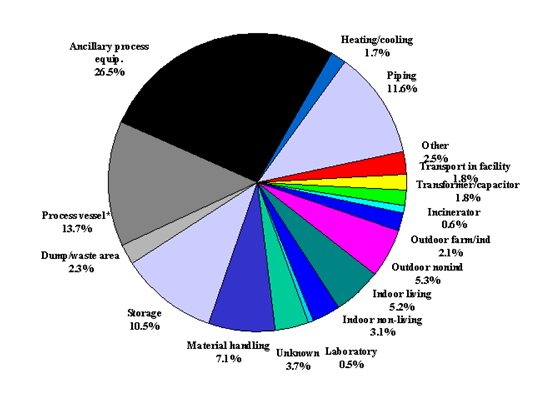
Indoor @ res=an area inside a place where someone is residing.
Indoor nonres=inside at a place that is not a residence (e.g., farm, industry, commercial business, and school).
Outside nonind=outside at a place that is nonindustrial, or nonfarming (e.g., driveways, yards, roofs at residences, and schools).
Outside ind=outside at an industry or farming area.
Figure 2. – Distribution of transportation-related events, by type of transport, Hazardous Substances Emergency Events Surveillance, 2001.*
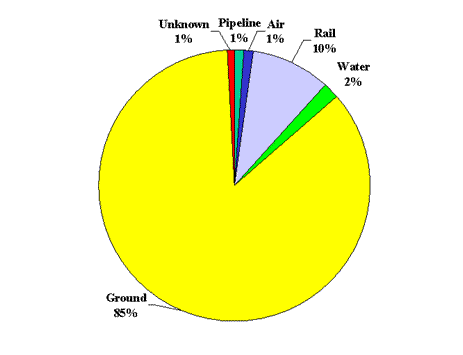
*Five events had a combination of transportation types: three events, ground and rail; two events, water and pipeline.
Figure 3. – Factors reported as contributing to the occurrence of fixed-facility events, Hazardous Substances Emergency Events Surveillance, 2001.
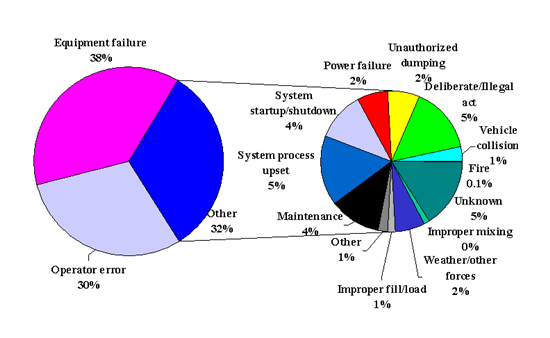
Table 2. – Distribution of the number of substances released, by type of event, Hazardous Substances Emergency Events Surveillance, 2001.
|
No. of subs. released |
Type of event |
All events | |||||||
|---|---|---|---|---|---|---|---|---|---|
| Fixed facility | Transportation | ||||||||
| No. of events | (%) | No. of subs. | No. of events | (%) | No. of subs. | No. of events | (%) | No. of Subs. | |
| 1 | 6,016 | 89.3 | 6,016 | 2,122 | 94.6 | 2,122 | 8,138 | 90.6 | 8,138 |
| 2 | 314 | 4.7 | 628 | 78 | 3.5 | 156 | 392 | 4.4 | 784 |
| 3 | 165 | 2.4 | 495 | 31 | 1.4 | 93 | 196 | 2.2 | 588 |
| 4 | 128 | 1.9 | 512 | 3 | 0.1 | 12 | 131 | 1.5 | 524 |
| ≥ 5 | 113 | 1.7 | 1,686 | 8 | 0.4 | 44 | 121 | 1.3 | 1,730 |
| Total* | 6,736 | 100.0 | 9,337 | 2,242 | 100.1 | 2,427 | 8,978 | 100.0 | 11,764 |
*Total may not equal 100% due to rounding.
Table 3. – Distribution of the number of substances released, by substance category and type of event, Hazardous Substances Emergency Events Surveillance, 2001.
|
Substance Category | Type of event |
All events | ||||
|---|---|---|---|---|---|---|
| Fixed facility | Transportation | |||||
| No. of subs. | (%) | No. of subs. | (%) | No. of subs. | (%) | |
| Acids | 544 | 5.8 | 315 | 13.0 | 859 | 7.3 |
| Ammonia | 511 | 5.5 | 82 | 3.4 | 593 | 5.0 |
| Bases | 198 | 2.1 | 218 | 9.0 | 416 | 3.5 |
| Chlorine | 143 | 1.5 | 6 | 0.2 | 149 | 1.3 |
| Other inorganics* | 2,789 | 29.9 | 230 | 9.5 | 3,019 | 25.7 |
| Paints and dyes | 123 | 1.3 | 123 | 5.1 | 246 | 2.1 |
| Pesticides | 271 | 2.9 | 153 | 6.3 | 424 | 3.6 |
| PCBs | 102 | 1.1 | 7 | 0.3 | 109 | 0.9 |
| VOCs | 2,079 | 22.3 | 460 | 19.0 | 2,539 | 21.6 |
| Mixtures† | 1,084 | 11.6 | 77 | 3.2 | 1,161 | 9.9 |
| Other‡ | 1,489 | 16.0 | 753 | 31.1 | 2,242 | 19.1 |
| Total** | 9,333 | 100.0 | 2,424 | 100.1 | 11,757 | 100.0 |
*All inorganic substances except for acids, bases, ammonia, and chlorine.
†Mixtures of substances from different categories.
‡Not classified.
**Total may not equal 100% due to rounding, 7 substances, 3 transportation and 4 fixed facility, were missing a category.
A total of 2,168 victims were involved in 710 events (7.9% of all events) (Table 4). Of the 710 events with victims, 440 (62.0 %) events involved only one victim, and 557 (78.5%) events involved either one or two victims. Of the 2,168 total victims, 1,921 (88.61%) were injured in fixed-facility events.
The substances released most often were not necessarily the most likely to result in victims (Table 5). For example, other inorganic substances were released 3,019 times; however, only 159 (5.3%) of these events resulted in injury. Conversely, chlorine was released in only 149 events, but 28 (18.8%) of these events resulted in injury, which indicates chlorine's greater potential for immediate harm.
*Employees (1,102 or 50.8%) were the population groups most often injured, followed by the general public (613 or 28.3%), responders (274 or 12.6%), and students (178 or 8.2%) (Figure 4). The population group was unknown for 1 victim. There were 227 emergency response personnel injured in fixed-facility events. Of those, 96 (42.3%) were police, 72 (31.7%) were career firefighters, and 28 (12.3%) volunteer firefighters (Figure 5a). There were 47 emergency-responder victims injured in transportation-related events. Of these, the majority (34, 72.3%) were police officers (Figure 5b).
The types of injuries sustained by victims are shown in Table 6 and Figure 6. Victims sustained a total of 3,830 injuries. Some victims had more than one injury. The most commonly reported injuries in fixed-facility events were respiratory irritation (1,083 or 30.7%), headache (435 or 12.3%), dizziness or other central nervous system (CNS) symptoms (425 or 12.0%), eye irritation (401 or 11.4%), and gastrointestinal problems (338 or 9.6%). In transportation-related events, trauma (95 or 31.9%), respiratory irritation (62 or 20.8%), eye irritation (34 or 11.4%), and headache (27 or 9.1%) were reported most frequently. Trauma was reported more frequently in transportation-related events (31.9%) than in fixed-facility events (2.4%). The trauma might have been caused by the sequence of events (for example, a motor vehicle accident) leading to the release of a hazardous substance, and not necessarily by exposure to the hazardous substance itself.
The sex of 1,428 (65.9%) of the victims was known; of these, 918 (64.2%) were male. The mean age of the 48.5% of victims with a specified age was 31 years (range: 1-86 years). For the 1,106 (49.2%) of injured persons for whom specific age was unknown, 819 (70.8%) were adults (first responders or employees), 46 (4.0%) were children (students), and 291 (25.2%) could have been adults or children (general public or unknown victim category). Most of the 1,164 (54.1%) victims were transported to a hospital and treated on an outpatient basis, and 22 (1.0%) died (Figure 7). Appendix B details the fixed-facility events in which deaths occurred. Appendix C details the transportation events in which deaths occurred.
Among the 2,133 victims whose personal protective equipment use was documented, 770 (71.8%) of employees, 559 (91.8%) of the general public, 96 (46.8%) of emergency responders, and 177 (99.4%) of students had not worn any form of personal protective equipment. Gloves were worn by 6% of injured employees and firefighter turn out gear was worn by 33% of responders and another 14% wore gloves. Firefighter turnout gear is protective clothing normally worn by firefighters during structural fire-fighting operations, and is similar to level "D" protection. Level "D" as defined by the Occupational Safety and Health Administration is coveralls, boots/shoes (leather or chemical resistant, steel toe and shank), safety glasses or chemical splash goggles, and hard hat. Level "D" provides very limited protection against chemical hazards.
Table 7 lists the 3 events in which 50 or more people were injured. Fifty-two students, 56 public, 40 firefighters, 5 police officers, and 3 emergency medical technicians were injured in these three events alone. A variety of substances was involved and a variety of signs and symptoms were observed. Forty-five of these victims were serious enough to be seen at the hospital or die.
*Evacuations were ordered in 655 events, and the evacuation status of 42 events was unknown. Of known evacuations, 71% were of a building or the affected part of a building, 16% were of a defined circular radius surrounding an event, 6% were of a downwind/downstream area, 4% were reported as having a circular and downwind/downstream area, and 3% had no criteria. The median number of persons evacuated was 20. In 69 events, in-place sheltering was ordered by an official, and instructions regarding precautions to take during in-place sheltering were provided by an official in 55 of these events.
*A contingency plan was followed in 95% of events. The types of contingency or preparedness plans used during an event varied, with 72% involving the use of company operating procedures. Twenty-three percent of events were reported as using HAZMAT/Response team standard operating procedures, and 3% of events were reported as using an incident-specific ad hoc plan.
Following the terrorist attacks on the World Trade Center (WTC) on September 11, 2001, New York HSEES staff collected information on chemical releases and injuries. Because of the magnitude of the event, this event was not included in analysis for this report. At the time of the attacks, 11,336 firefighters and 2,908 EMS workers were employed by Fire Department City of New York (FDNY). During the collapse, 343 FDNY rescue workers died (341 firefighters and two paramedics). During the first 24 hours, 240 FDNY rescue workers (158 firefighters and 82 EMS workers) sought emergency medical treatment. Most (63%) were for eye irritation, respiratory tract irritation and exposure not requiring hospital admission. Of 28 FDNY rescue workers who required hospitalization, 24 had traumatic injuries. Three FDNY rescue workers required hospital admission for life-threatening inhalation injuries. Eight FDNY rescue workers were evaluated for chest pain, and one EMS worker was admitted for suspected myocardial infarction.2
Toxic substances of concern included asbestos from insulation and fireproofing material, carbon monoxide from fires, mercury (from fluorescent lights), chlorodifluoromethane (Freon-22TM) from air conditioning systems, heavy metals from building materials, hydrogen sulfide from sewers, inorganic acids, VOCs, and polynuclear aromatic hydrocarbons from fires.
Table 4. – Distribution of the number of victims, by type of event, Hazardous Substances Emergency Events Surveillance, 2001.| No. of victims | Type of event | All events | |||||||
|---|---|---|---|---|---|---|---|---|---|
| Fixed facility | Transportation | ||||||||
| No. of events | (%) | No. of victims | No. of events | (%) | No. of victims | No. of events | (%) | No. of victims | |
| 1 | 338 | 60.6 | 338 | 102 | 67.1 | 102 | 440 | 62.0 | 440 |
| 2 | 91 | 16.3 | 182 | 26 | 17.1 | 52 | 117 | 16.5 | 234 |
| 3 | 37 | 6.6 | 111 | 17 | 11.2 | 51 | 54 | 7.6 | 162 |
| 4 | 20 | 3.6 | 80 | 3 | 2.0 | 12 | 23 | 3.2 | 92 |
| 5 | 12 | 2.2 | 60 | 1 | 0.7 | 5 | 13 | 1.8 | 65 |
| ≥ 6 | 60 | 10.8 | 1150 | 3 | 2.0 | 25 | 63 | 8.9 | 1175 |
| Total | 558 | *100.1 | 1921 | 152 | *100.1 | 247 | 710 | 100.0 | 2168 |
Table 5. – Number of substances released in all events and events with victims, by substance category, Hazardous Substances Emergency Events Surveillance, 2001.
| Substance category | Total Number of releases | % | No. of releases with victims | % | % of releases in substance category |
|---|---|---|---|---|---|
| Acids | 859 | 7.3 | 122 | 12.3 | 14.2 |
| Ammonia | 593 | 5.0 | 108 | 10.9 | 18.2 |
| Bases | 416 | 3.5 | 29 | 2.9 | 7.0 |
| Chlorine | 149 | 1.3 | 28 | 2.8 | 18.8 |
| Other inorganics* | 3,019 | 25.7 | 159 | 16.1 | 5.3 |
| Paints and dyes | 246 | 2.1 | 13 | 1.3 | 5.3 |
| Pesticides | 424 | 3.6 | 72 | 7.3 | 17.0 |
| Polychlorinated biphenyls | 109 | 0.9 | 2 | 0.2 | 1.8 |
| VOCs | 2,539 | 21.6 | 191 | 19.3 | 7.5 |
| Mixtures† | 1,161 | 9.9 | 75 | 7.6 | 6.5 |
| Other‡ | 2,242 | 19.1 | 191 | 19.3 | 8.5 |
| Total | 11,757 | 100.0 | 100.0 |
*All inorganic substances except for acids, bases, ammonia, and chlorine.
†Mixtures of substances from different categories.
‡Not classified.
*Figure 4. – Distribution of victims, by population group* and type of event, Hazardous Substances Emergency Events Surveillance, 2001.

*Population group was unknown for 1 person injured in a fixed-facility event.
Figure 5a. – Distribution of responders injured in fixed-facility events,* by population group, Hazardous Substances Emergency Events Surveillance, 2001.
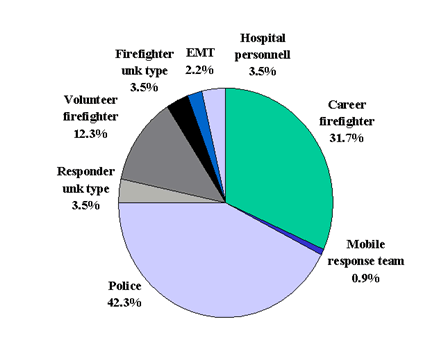
*A total of 227 responders were injured during fixed-facility events.
*Figure 5b. – Distribution of responder victims for transportation-related events,* by population group, Hazardous Substances Emergency Events Surveillance, 2001.
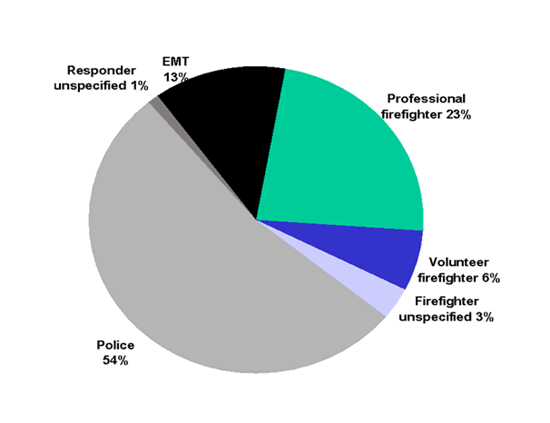
*A total of 47 responders were injured during transportation-related events.
Table 6. – Distribution of type of injury, by type of event,* Hazardous Substances Emergency Events Surveillance, 2001.
Type of Injury | Type of Event | All events |
||||
|---|---|---|---|---|---|---|
| Fixed facility | Transportation | |||||
| No. of injuries | (%) | No. of injuries | (%) | No. of injuries | (%) | |
| Chemical burns | 155 | 4.4 | 23 | 7.7 | 178 | 4.7 |
| Heart problems | 27 | 0.8 | 1 | 0.3 | 28 | 0.7 |
| Dizziness/CNS† | 425 | 12.0 | 12 | 4.0 | 437 | 11.4 |
| Eye irritation | 401 | 11.4 | 34 | 11.4 | 435 | 11.4 |
| Headache | 435 | 12.3 | 27 | 9.1 | 462 | 12.1 |
| Heat stress | 11 | 0.3 | 1 | 0.3 | 12 | 0.3 |
| Gastrointestinal problems | 338 | 9.6 | 7 | 2.4 | 345 | 9.0 |
| Respiratory system | 1083 | 30.7 | 62 | 20.8 | 1145 | 29.9 |
| Shortness of breath | 148 | 4.2 | 4 | 1.3 | 152 | 4.0 |
| Skin Irritation | 184 | 5.2 | 21 | 7.1 | 205 | 5.4 |
| Thermal burns | 122 | 3.5 | 2 | 0.7 | 124 | 3.2 |
| Trauma | 85 | 2.4 | 95 | 31.9 | 180 | 4.7 |
| Other | 118 | 3.3 | 9 | 3.0 | 127 | 3.3 |
| Total | 3532 | 100.1 | 298 | 100.0 | 3830 | 100.1 |
†Central nervous system symptoms.
Figure 6. – Distribution of type of injury for all events*, Hazardous Substances Emergency Events Surveillance, 2001.
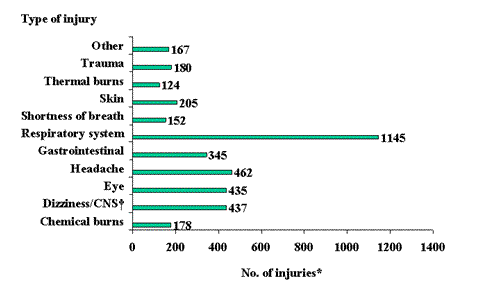
*A total of 3,830 injuries was reported. The number of injuries was greater than the number of victims because some victims had more than one injury.
†Central nervous system symptoms.
Figure 7. – Injury outcome*, Hazardous Substances Emergency Events Surveillance, 2001.
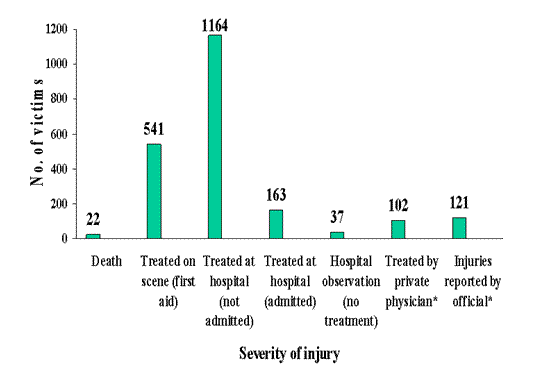
*Within 24 hours.
Table 7. – Profiles of events with ≥ 50 victims, Hazardous Substances Emergency Events Surveillance, 2001.
| Victim Type | No. of Victims | Treatment(s) | Chemical(s) | Injuries |
|---|---|---|---|---|
| General Public | 54 | 2 admitted to hospital, 19 treated and released from hospital, 33 treated on scene | Carbon monoxide | Gastrointestinal, headache, dizziness and other central nervous system, other |
| 5 police, 3 EMTs, 2 general public 40 firefighters | 50 | 3 died, 16 admitted to hospital, 28 treated on scene, 3 treated and released from hospital | Paint, propane, solvent, kerosene, gasoline | Trauma, thermal burns, respiratory system, other |
| Students | 52 | 50 treated on scene, 2 treated and released from hospital | Dimethyl sulfide, Dimethyl disulfide, Hydrogen sulfide, Methyl mercaptan | Dizziness, respiratory system symptoms, gastrointestinal symptoms |
During 2001, ATSDR continued to respond to requests for HSEES information from local, state, and federal agencies and organizations. ATSDR also continued to respond to requests from researchers for copies of the HSEES protocol, data collection form, data, and publications. HSEES data have been used to produce the publications listed in Appendix D.
The HSEES Internet Web site page is available at http://www.atsdr.cdc.gov/HS/HSEES/. At this site, HSEES annual reports and other information can be downloaded to a user's personal computer. Internet links to other relevant Web sites and a public use dataset will be available on the HSEES Web site in the future.
Current activities include collaboration with the Federal Emergency Management Agency, the US Chemical Safety and Hazard Investigation Board, the US Environmental Protection Agency and other agencies and organizations involved with response to chemical terrorism, emergency response, hazardous substances releases, and public health. Nine years of HSEES data are now available for trend analysis, and several publications are still in development. Participating states have been working on implementing and analyzing the effectiveness of their prevention outreach plans.
The number of events, substances released, events with victims, and deaths for the years 1993 through 2001 are shown in Table 8. During this period, most events involved a single substance at fixed facilities. However, the number of transportation events is increasing, partially the result of using the US Department of Transportation's Hazardous Materials Information System as a primary notification source for transportation events. The total number of events and the number of substances released during 1993-2001 continued to rise. This is partially explained by new states being added; however, the number of events in states that have been in the system since 1993 grows every year.
Respiratory symptoms have consistently been most frequently reported. The number of deaths associated with events continues to suggest the need to evaluate not only the danger posed by exposure to hazardous substances, but also the circumstances surrounding the occurrence of events. Employees continue to be the most commonly reported victims of emergency events (Figure 8). Cumulative data on the number of events, substances, victims, and events involving victims are displayed in Figure 9.
HSEES data regarding risk factors related to the occurrence of emergency events and the associated morbidity and mortality have multiple uses. The states and ATSDR use the results of data analysis for prevention activities aimed at several different target groups, including school personnel, industry and labor groups, first responders, hospital personnel, and producers or users of potentially dangerous substances.
Table 8. – Cumulative data for all states, Hazardous Substances Emergency Events Surveillance, 1993-2001.*
| Year | No. of states | Type of Event | Total | No. of substances released | No. of deaths | No. of victims | Events with victims No. (%)† |
|
|---|---|---|---|---|---|---|---|---|
| Fixed facility | Transportation | |||||||
| 1993 | 11 | 3,199 | 634 | 3,833 | 4,361 | 16 | 2,230 | 464(12) |
| 1994 | 12 | 3,321 | 912 | 4,233 | 5,073 | 21 | 2,181 | 414(10) |
| 1995 | 14 | 4,273 | 1,037 | 5,310 | 6,027 | 14 | 1,688 | 402 (8) |
| 1996 | 14 | 4,327 | 1,159 | 5,486 | 5,862 | 33 | 1,622 | 390 (7) |
| 1997 | 13 | 4,385 | 1,128 | 5,513 | 6,089 | 28 | 1,896 | 372 (7) |
| 1998 | 13 | 4,729 | 1,252 | 5,981 | 6,486 | 36 | 1,533 | 405 (7) |
| 1999 | 13 | 4,634 | 1,626 | 6,260 | 6,974 | 30 | 1,912 | 504 (8) |
| 2000 | 15 | 5,499 | 2,049 | 7,548 | 8,384 | 44 | 2,513 | 752(10) |
| 2001 | 16 | 6,736 | 2,242 | 8,978 | 11,764 | 22 | 2,168 | 710 (8) |
| Total | 41,103 | 12,039 | 53,142 | 61,020 | 244 | 17,743 | 4,413 | |
*Numbers in the table may differ from those reported in previous years because of adjustments in HSEES qualification requirements for events.
†Percentage of events with victims.
Figure 8. – Distribution of victims, Hazardous Substances Emergency Events Surveillance, 1993-2001.†
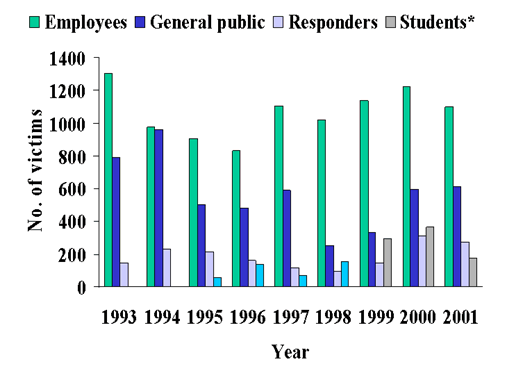
*The student category was not available before 1995.
†The numbers of unknown victims were as follows: 14 for 1993, six for 1994, three for 1996, 14 for 1997, eight for 1998, one for 1999, and 17 for 2000, and 1 for 2001.
Figure 9. –Cumulative data for all participating states, Hazardous Substance Emergency Events Surveillance, 1993-2001.
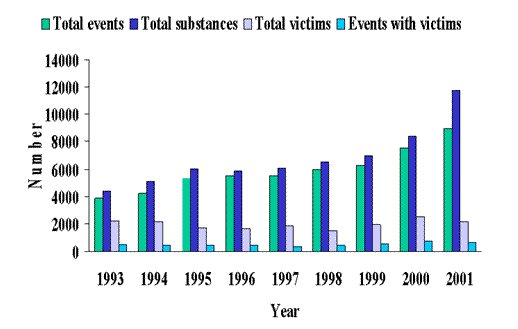
1. Binder S. Death, injuries, and evacuations from acute hazardous materials releases. Am J Public Health 1989;79:1042-4.
2. Centers for Disease Control and Prevention. MMWR. Injuries and Illnesses Among New York City Fire Department Rescue Workers After Responding to the World Trade Center Attacks. September 11,2001 51 (special issue);1-5.
Appendix A. – The 100 Most Frequently Released Substances, Hazardous Substances Emergency Events Surveillance, 2001| Number | Standardized Substance Name | No. of releases |
| 1. | Ammonia | 560 |
| 2. | Sulfur Dioxide | 466 |
| 3. | Carbon Monoxide | 344 |
| 4. | Nitric Oxide | 327 |
| 5. | Sodium Hydroxide | 226 |
| 6. | Hydrochloric Acid | 213 |
| 7. | Mercury | 212 |
| 8. | Sulfuric Acid | 203 |
| 9. | Ethylene Glycol | 160 |
| 10. | Oxides of Nitrogen NOS | 156 |
| 11. | Hydrogen Sulfide | 150 |
| 12. | Chlorine | 145 |
| 13. | Paint or Coating NOS | 125 |
| 14. | Benzene | 122 |
| 15. | Corrosive NOS | 112 |
| 16. | Polychlorinated Biphenyls | 108 |
| 17. | VOC, NOS | 105 |
| 18. | Nitrogen Oxide (NOx) | 90 |
| 19. | Pesticide NOS | 90 |
| 20. | Vinyl Chloride | 90 |
| 21. | Nitrogen Dioxide | 86 |
| 22. | Acid NOS | 82 |
| 23. | Solvent NOS | 82 |
| 24. | Resin Solution | 80 |
| 25. | Chlorodifluoromethane | 77 |
| 26. | Potassium Hydroxide | 74 |
| 27. | Phosphoric Acid | 72 |
| 28. | MIX: Hydrogen Sulfide Sulfur Dioxide | 71 |
| 29. | Methamphetamine Chemicals NOS | 71 |
| 30. | Sodium Hypochlorite | 69 |
| 31. | Ethanol | 64 |
| 32. | Chloroform | 63 |
| 33. | Xylene | 63 |
| 34. | Adhesive NOS | 61 |
| 35. | Isopropanol | 57 |
| 36. | Butadiene | 55 |
| 37. | Paint | 54 |
| 38. | Methanol | 49 |
| 39. | VOC | 48 |
| 40. | Freon NOS | 47 |
| 41. | Hydraulic Oil | 46 |
| 42. | Acetone | 44 |
| 43. | Toluene | 41 |
| 44. | Ethylene Oxide | 40 |
| 45. | Methamphetamine Chemicals | 40 |
| 46. | Nitrous Oxide | 39 |
| 47. | Diesel Fuel | 38 |
| 48. | Hydrogen Peroxide | 38 |
| 49. | Methylene Chloride | 38 |
| 50. | Propane | 37 |
| 51. | Asbestos | 34 |
| 52. | Base NOS | 33 |
| 53. | Fertilizer NOS | 33 |
| 54. | Flammable Liquid NOS | 33 |
| 55. | Carbon Tetrachloride | 32 |
| 56. | Ethylene Dichloride | 32 |
| 57. | Ephedrine | 31 |
| 58. | Phosphorus | 31 |
| 59. | Ink NOS | 30 |
| 60. | Nitrogen Fertilizer | 30 |
| 61. | Ethyl Ether | 29 |
| 62. | Acetic Acid | 27 |
| 63. | Cleaning Agent NOS | 27 |
| 64. | Hydrocarbon NOS | 27 |
| 65. | MIX: Acetylene/Carbon Monoxide/Hydrogen Sulfide/Nitrogen Dioxide | 27 |
| 66. | Hydrofluoric Acid | 25 |
| 67. | Nitric Acid | 25 |
| 68. | DOT 1993: Flammable Liquids, N.O.S. | 24 |
| 69. | Black Liquor* | 23 |
| 70. | Methyl Ethyl Ketone | 23 |
| 71. | Resin NOS | 23 |
| 72. | Ether NOS | 22 |
| 73. | Formaldehyde | 22 |
| 74. | Hydraulic Fluid | 22 |
| 75. | Isopropylamine Glyphosate | 22 |
| 76. | Latex Paint | 22 |
| 77. | Urea Ammonium Nitrate | 22 |
| 78. | Carbon Dioxide | 21 |
| 79. | Iodine | 21 |
| 80. | Propylene Glycol | 21 |
| 81. | Ammonia NOS | 20 |
| 82. | Styrene | 20 |
| 83. | Battery Acid NOS | 18 |
| 84. | DOT 1760: Corrosive Liquids, N.O.S. | 18 |
| 85. | MIX: Nitric Oxide/Nitrogen Dioxide | 18 |
| 86. | Malathion | 18 |
| 87. | Sulfur | 18 |
| 88. | Alcohol NOS | 17 |
| 89. | MIX: Carbon Monoxide/Oxides of Nitrogen NOS | 17 |
| 90. | MIX: Nitrogen Dioxide/Sulfur Dioxide | 17 |
| 91. | Nitrogen | 17 |
| 92. | Creosote | 16 |
| 93. | EPA F039: Multi-Code Treatment, | 16 |
| 94. | Ethylene | 16 |
| 95. | Freon | 16 |
| 96. | Peroxide NOS | 16 |
| 97. | Sulfur Dioxide NOS | 16 |
| 98. | Ammonium Nitrate | 15 |
| 99. | Hydrogen Sulfide NOS | 15 |
| 100. | Methamphetamine | 15 |
| Total | 5646 | |
VOC=volatile organic compound.
NOS=not otherwise specified.
Appendix B. – Profiles of Events with Fatalities in Fixed Facilities, Hazardous Substances Emergency Events Surveillance, 2001.
| Industry/ Location |
Type of release | Chemicals | Factors | Victim category | Sex | Injury | PPE |
|---|---|---|---|---|---|---|---|
| Hospital | Spill | Cronex | Equipment failure | 10 employees | 10 U | Respiratory system problems | None |
| Ferrous metal scrap and waste material | Air, explosion | Liquid oxygen | Human error | 3 employees | 3 M | Trauma | None |
| Retail furniture and improvement | Fire | Mix of carbon monoxide and solvent | Unknown cause | 1 Employee | 1 M | Respiratory irritation | None |
| +Retail hardware store | Fire | Paint, solvent, gasoline, kerosene and propane | Illegal activity | 40 career firefighters (3 fatal), 3 EMS, 5 law enforcement, 1 public | 17 M 2 F 31 U |
Trauma, respiratory irritation, smoke inhalation, thermal burns | Firefighters in turn out gear, others none |
| Private residence | Spill | Dinitrophenol | Operator error | 1 public | 1 M | Poisoning | None |
| Steel parts manufacturer | Spill | Sodium hydroxide | Operator error | 4 employees | 1 M 3 U |
Chemical and thermal burns | Firefighter turnout gear |
| Paint contractor | Explosion | Paint fumes | Operator error | 1 employee | 1 M | Thermal burns | None |
| Private residence | Air | Carbon monoxide | Operator error | 3 public | 3 M | GI dizzy/ CNS, headache, asphyxiation | None |
| Manufacturer smoked meat products | Spill and air | Anhydrous ammonia | Operator error | 2 employees | 2 M | Chemical burns and respiratory irritation | None |
| Private residence | Air | Carbon monoxide | Operator error | 2 public-both fatal | 1 M 1 F |
Asphyxiation | None |
+This event involved 3 deaths, all others involved one each.
PPE=Personal protective equipment.
M=male.
F=female.
U=unknown.
GI=gastrointestinal.
CNS=central nervous system.
Appendix C. – Profiles of Events with Fatalities in Transportation Events, Hazardous Substances Emergency Events Surveillance, 2001.
| Industry/ Location |
Type of release | Chemicals | Factors | Victim category | Sex | Injury | PPE |
|---|---|---|---|---|---|---|---|
| Lawn maintenance | Spill | Fertilizer | Operator error-motor vehicle mishap | 2 public | 2 M | Trauma | None |
| Trucking | Spill and fire | Phosphoric acid | Unknown | 1 employee | 1 M | Thermal burns | U |
| Trucking | Spill | Isopropylamine glyphosphate | Operator error-motor vehicle mishap | 1 employee, 3 public | 2 M 2 F |
Trauma | None |
| Mobile methamphet-amine lab | Air | Ammonia | Illegal activity | 2 public, 1 police officer |
2 M 1 U |
Chemical burns Respiratory irritation |
None |
| Trucking | Spill | Urea ammonium nitrate | Operator error-motor vehicle mishap | 1 employee | 1 M | Trauma | U |
| Trucking | Spill | Lead Sulfate | Operator error | 1 employee | 1 M | Trauma | None |
| Trucking | Spill and fire | Detergent and diesel fuel | Motor vehicle mishap-cause unknown | 1 public | 1 M | Trauma | None |
| Unknown industry-found on highway | Spill | Latex sealant | Operator error | 2 employee, 1 public | 3 F | Trauma | None |
| Personal vehicle hit tanker | Spill and threaten | Nitrogen and diesel fuel | Operator error-motor vehicle mishap | 3 public | 3 M | Trauma | None |
M=male, F=female, U=unknown.
Each event involved one death.
Appendix D. – Hazardous Substances Emergency Events Surveillance-Related Publications Agency for Toxic Substances and Disease Registry. Hazardous Substances Emergency Events Surveillance annual report, 1993. Atlanta: US Department of Health and Human Services; 1994.
Agency for Toxic Substances and Disease Registry. ATSDR update: Hazardous Substances Emergency Events Surveillance (HSEES) system: 1993 data. Health and Environment Digest 1995;8:83-4.
Agency for Toxic Substances and Disease Registry. Hazardous Substances Emergency Events Surveillance annual report, 1994. Atlanta: US Department of Health and Human Services; 1995.
Agency for Toxic Substances and Disease Registry. Hazardous Substances Emergency Events Surveillance System: information for local emergency planning committees and first responders. Atlanta: US Department of Health and Human Services; 1995.
Agency for Toxic Substances and Disease Registry. Hazardous Substances Emergency Events Surveillance annual report, 1995. Atlanta: US Department of Health and Human Services; 1996.
Agency for Toxic Substances and Disease Registry. Hazardous Substances Emergency Events Surveillance annual report, 1996. Atlanta: US Department of Health and Human Services; 1997.
Agency for Toxic Substances and Disease Registry. Hazardous Substances Emergency Events Surveillance annual report, 1997. Atlanta: US Department of Health and Human Services; 1998.
Agency for Toxic Substances and Disease Registry. Hazardous Substances Emergency Events Surveillance annual report, 1998. Atlanta: US Department of Health and Human Services; 1999.
Agency for Toxic Substances and Disease Registry. Hazardous Substances Emergency Events Surveillance five-year cumulative report 1993-1997. Atlanta: US Department of Health and Human Services; 2001.
Agency for Toxic Substances and Disease Registry. Hazardous Substances Emergency Events Surveillance biennial report, 1999-2000. Atlanta: US Department of Health and Human Services; 2002.
Berkowitz Z, Haugh GS, Orr MF, Kaye WE. Releases of hazardous substances in schools: data from Hazardous Substances Emergency Events Surveillance system, 1993-1998. J Environ Health 2002;65:20-7.
Berkowitz Z, Orr MF, Kaye WE, Haugh GS. Adverse public health effects associated with releases of hazardous substances in the agricultural industry and related services in four mid-Western states. J Occup Environ Med 2002;44:714-23.
Burgess JL, Kovalchick DF, Harter L, Kyes KB, Thompson JN. Hazardous materials events: an industrial comparison. J Occup Environ Med 2000;42:546-53.
Burgess JL, Kovalchick DF, Harter L, Kyes KB, Lymp JF, Brodkin CA. Hazardous materials events: evaluation of transport to health care facility and evacuation decisions. Am J Emerg Med 2001;19:99-105.
Centers for Disease Control and Prevention. Public health consequences among first responders to emergency events associated with illicit methamphetamine laboratories– selected states, 1996-1999. MMWR 2000;49:1021-4.
Centers for Disease Control and Prevention. Homemade chemical bomb events and resulting injuries–selected states, January 1996-March 2003. MMWR 2003;52:662-4.
Hall HI, Dhara VR, Price-Green PA, Kaye WE. Surveillance for emergency events involving hazardous substances–United States, 1990-1992. MMWR 1994;43(No. SS-2):1-6.
Hall HI, Dhara VR, Kaye WE, Price-Green PA. Surveillance of hazardous substance releases and related health effects. Arch Environ Health 1994;49:45-8.
Hall HI, Price-Green PA, Dhara VR, Kaye WE. Health effects related to releases of hazardous substances on the Superfund priority list. Chemosphere 1995;31:2455-61.
Hall HI, Dhara VR, Kaye WE, Price-Green PA. Public health consequences of hazardous substance releases. Toxicol Ind Health 1996;12:289-93.
Hall HI, Haugh GS, Price-Green PA, Dhara VR, Kaye WE. Risk factors for hazardous substance releases that result in injuries and evacuations: data from 9 states. Am J Public Health 1996;86:855-7.
Horton DK, Berkowitz Z, Haugh GS, Orr MF, Kaye WE. Acute public health consequences associated with hazardous substances released during transit, 1993-2000. J Hazard Mater 2003;B98:161-75.
Horton DK, Berkowitz Z, Kaye WE. The public health consequences from acute chlorine releases, 1993-2000. J Occup Environ Med 2002;44:906-913.
Horton DK, Berkowitz Z, Kaye WE. The acute consequences to children exposed to hazardous substances used in illicit methamphetamine production, 1996 to 2001. Journal Children's Health 2003;1:99-108.
Horton DK, Berkowitz Z, Kaye WE. Secondary contamination of ED personnel from hazardous materials events, 1995-2001. Am J Emerg Med 2003;21:199-204.
Manassaram DM, Orr MF, Kaye WE. Counterterrorism planning using the hazardous substances events surveillance system. Disaster Management and Response 2003;1:35-40.
Orr MF, Kaye WE, Zeitz P, Powers ME, Rosenthal L. Public health risks of railroad hazardous substance emergency events. J Occup Environ Med 2001;43:94-100.
Orr MF, Kaye WE, Zeitz P, Powers ME, Rosenthal L. Letter to editor: Public health risks of railroad hazardous substance emergency events. J Occup Environ Med 2001;43:738-40.
Orr MF, Haugh GS, Kaye WE. Hazardous Substances Emergency Events Surveillance, 1993 to 1997. Chemical Health and Safety. Jan/Feb 2001:35-41.
Souther L, Small-Johnson J, Messing RB. A description of agricultural releases of anhydrous ammonia in Minnesota. Chemical Health and Safety. Nov/Dec 2000: 16-22.
Weisskopf MG, Drew JM, Hanrahan LP, Anderson HA. Hazardous ammonia releases in Wisconsin: trends and risk factors for evacuation and injury. W M J. Nov 2000:30-46.
Welles WL, Wilburn RE. Hazardous Substances Emergency Events Surveillance (HSEES) in New York State, 1993 to 1997. Chemical Health and Safety. Jan/Feb 2001:42-52.
Wendt RD, Hall HI, Price-Green PA, Dhara VR, Kaye WE. Evaluating the sensitivity of hazardous substances emergency events surveillance: a comparison of three surveillance systems. J Environ Health 1996;58:13-7
Zeitz P, Berkowitz Z, Orr MF, Haugh GS, Kaye WE. Frequency and type of injuries in responders of hazardous substances emergency events, 1996 to 1998. J Occup Environ Med 2000;42:1115-20.
Zeitz P, Orr MF, Kaye WE. Public health consequences of mercury spills: Hazardous Substances Emergency Events Surveillance System: 1993-1998. Environ Health Perspect 2002;110:129-32.
Other HSEES documents available:
1995 Annual Report [HTML] [![]() ]
]
1996 Annual Report [HTML] [![]() ]
]
1997 Annual Report [HTML] [![]() ]
]
1998 Annual Report [HTML] [![]() ]
]
1999-2000 Biennial Report [HTML]
[![]() ]
]
2001 Annual Report [![]() ]
]
2002 Annual Report [ HTML] [![]() ]
]
2003 Annual Report [HTML] [ ![]() ]
]
2004 Annual Report [HTML] [ ![]() ]
]
1993 through 1997 Annual Report [HTML ] [![]() ]
]
1998 through 2001 Annual Report [HTML] [![]() ]
]


